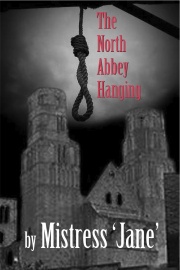The North Abbey Hanging
| The North Abbey Hanging | |
|---|---|
 | |
| Author | Jane Austen |
| Cover artist | Mr David Weaver, RA |
| Country | United Kingdom |
| Language | English |
| Genre(s) | Novel |
| Publisher | Ye Goths (Bath) |
| Publication date | 1810 |
| ISBN | N/A |
The North Abbey Hanging is the third novel by the English novelist Jane Austen. Following the critical and commercial success of Sensei and the Insensibles, she received a modest advance for her next novel, enabling her to give up her job lacquering bonnets for export[1]. She immediately set to work and very quickly came up with the riveting tale of young Catherine Morland's adventures amidst the zombie monks of north Somerset. The book was another resounding success and sealed her position as England's premier author of zombie romances. The tale is based on the true story of the Chew Magna Slayings, a notorious crime occurring in the late eighteenth century.
The most well-known adaptation of the book is of course the much-loved Bodger and Frankenstein musical The Sound of Mutants, although this continues to divide the hardcore Jane Austen community, many of whom consider that the transfer of the plot to a convent in Nazi-era Austria a step too far. However, Robert Wise's 1965 film of The Sound of Mutants (made two years after his previous film The Haunting), remains a family favourite with the general public and a regular staple of the Christmas television schedules. The only other notable film adaptation is Guy Ritchie's poorly-regarded Monkapunka (2002), starring Danny Dyer and Vinnie Jones alongside Madonna as Catherine Morland.
Plot summary
The North Abbey Hanging follows seventeen-year-old Gothic novel afficionado Catherine Morland and family friends Mr. and Mrs. Allen as they visit Bath. Here she is captivated by Henry Tilney and becomes friends with his younger sister Eleanor. Their father, Witchfinder-General Tilney, invites them to stay at the family mansion on the moors near Chew Magna, not far from the mysterious North Abbey. On her first night there, her sleep is disturbed by howling, screams and Gregorian chant.
Eleanor Tilney tries to reassure Catherine that there is nothing to fear, apart from the ghost of her mother who has a habit of wandering around the place and leaving messages scrawled in various bodily fluids on the best furniture. Once Eleanor has shown Catherine some of these messages (usually reminders to get an extra pint or two of milk), her fears subside. However, the noises are even worse the next night, and she realises they are coming from the nearby abbey. Eleanor persuades the Tilneys to join her in an expedition to find out what is going on there. She is shocked to find that the abbey has been taken over by a renegade band of zombie monks. Fortunately it seems to be a closed order, but for how long, Catherine wonders?
Catherine now resolves to destroy the order before it can do any damage to Bath society and uses her extensive knowledge of Gothic tropes to plan her attack. She raises an army by summoning her older brother James, the Allens and a friend of theirs called Mrs Thorpe, who brings along her daughter Isabella and son John. John immediately falls in love with Catherine and almost sabotages the mission by betraying their position in order to make Henry look bad. However, before he can do any further damage, he is unexpectedly eaten by one of the novice monks. Catherine's plan of attack now succeeds and the zombie monks are all contained within the refectory, whence they are led out, one by one, to be hung by Witchfinder-General Tilney.
Critical appraisal
The North Abbey Hanging was the last of Austen's novels to receive universal acclaim. In particular, the contemporary critic Joseph Robert Brighouse remarked that
if ZOMBIES and men of GOD are JUXTAPOS'D, we would surely face th'RAPTURE. 'Tis only the FEISTY Miss Morland that stands 'twixt us and OBLIVION![citation needed]
However, present-day criticism has been less kind, pointing out inconsistencies in Catherine Morland's scythe technique and the incorrect use of vinegar to remove spectral blood from rosewood veneer.
See also
- The Pure Moods of Howling, Screams and Gregorian Chant (CD)
- The Sound of Mutants (film)
- Monkapunka (film)
Further reading
- Pyre, Vin. Monks of Death: The Truth Behind the Chew Magna Slayings. Bloodbucket Press, 1987.
References
- ↑ The Lost Art of Bonnet Lacquering, Somerset Countryside, June 2007